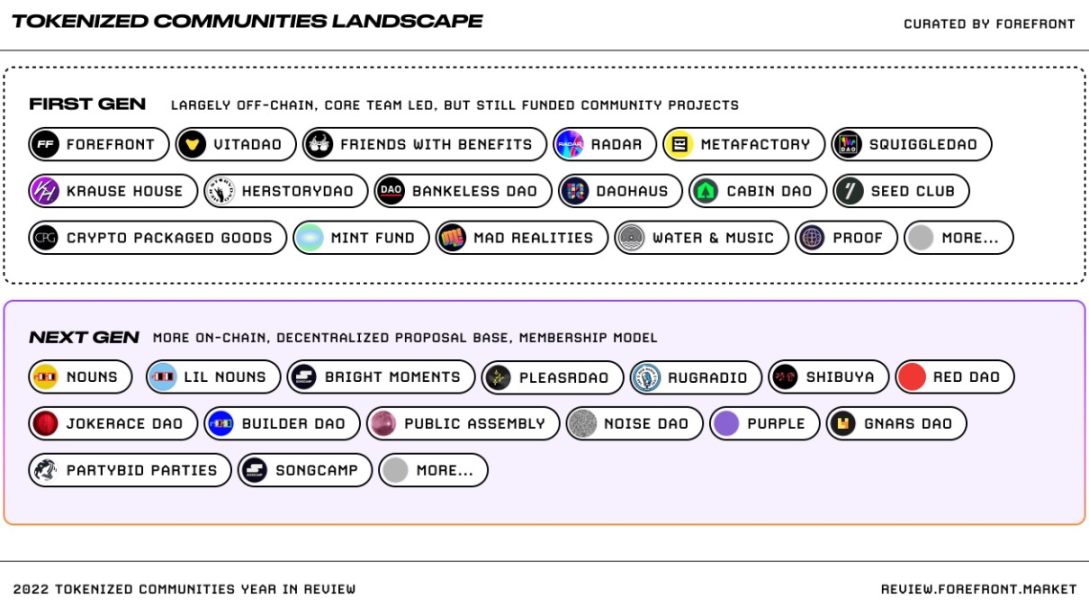เทรนด์ใหม่ของการเข้ารหัส: การลดลงของโทเค็นโซเชียลและการเพิ่มขึ้นของโทเค็นชุมชน?
การรวบรวมต้นฉบับ: Frank, Foresight News
การรวบรวมต้นฉบับ: Frank, Foresight News
นี่ไม่ใช่ครั้งแรกที่ Forefront มองย้อนกลับไปที่วิวัฒนาการประจำปีของการติดตามชุมชนโทเค็นในอุตสาหกรรมคริปโต แต่ไม่ต้องสงสัยเลยว่าสิ่งต่าง ๆ ได้เปลี่ยนไปอย่างมากในปี 2022
รายงานฉบับแรกของ Forefront "2020 Social Token ปีแห่งการทบทวนสำรวจภูมิทัศน์ที่เกิดขึ้นใหม่ของโซเชียลคริปโต ครอบคลุมที่มาของโทเค็นส่วนบุคคลผ่านเวลาโทเค็น ("Boi" ของแมทธิว เวอร์นอน) ข้อเสนอ ALEX เริ่มต้นของผู้ก่อตั้ง Showtime ในปัจจุบัน การพัฒนา RAC ในช่วงเริ่มต้น วิธีใช้ NFT เป็นวิธีการชำระเงิน ( Token WHALE), การเข้าถึงที่ได้รับอนุญาต (CollabLand) และอื่นๆ...
คุณต้องรู้ว่าในวันที่ 28 ธันวาคม 2020 มีโทเค็นโซเชียลบน Ethereum ไม่เกินสองสามโหลโดยมีผู้ถือทั้งหมดประมาณ 7,000 รายและมูลค่าตลาดรวม 81 ล้านดอลลาร์สหรัฐ การเฉลิมฉลองของความสำเร็จ แต่ ยังเป็นการเฉลิมฉลองโอกาสก่อนหน้าที่เราจะนำชุมชนโทเค็นไปสู่มวลชน
ตั้งแต่โทเค็นโซเชียลไปจนถึงโทเค็นชุมชน
ในตอนท้ายของปี 2020 ก่อนการเปิดตัวรายงานฉบับแรกของ Forefront Forefront เริ่มเปลี่ยนเป็น "บ้านโทเค็นโซเชียล" โดยค่อยๆ รวมทุกอย่างตั้งแต่โทเค็นผู้สร้างไปจนถึงโทเค็นนักสะสม NFT และโทเค็นโซเชียลทั้งหมด
เมื่อ NFT เริ่มเติบโตขึ้น ชุมชนใหม่ๆ ก็เริ่มปรากฏขึ้น และในไม่ช้าโทเค็นทางสังคมทั้งหมดเริ่มชัดเจนในทิศทางของโทเค็นชุมชน — การเปลี่ยนจากการสร้างรายบุคคลไปสู่การสร้างส่วนรวม
เป็นเพราะการเปลี่ยนแปลงดังกล่าวในเดือนกรกฎาคม 2021 มากกว่า 6 เดือนหลังจากออกรายงานการตรวจสอบประจำปีของโทเค็นโซเชียลดั้งเดิม ชุมชน Forefront รู้สึกว่าจำเป็นต้องทบทวนแนวโน้มการพัฒนาความเร็วแสงในสาขานี้อีกครั้ง
และ
และรายงานประจำปี 2564โดยเน้นย้ำถึงการเพิ่มขึ้นของฤดูกาลที่เป็นของชุมชน เช่น FWB และ Forefront, Roll Hack, Rally และ Bitclout ได้สร้างคลื่นอย่างต่อเนื่อง Bankless DAO ก็เปิดตัวเช่นกัน และชุมชนเช่น Cabin, Krause House และ Songcamp ก็ได้เริ่มต้นขึ้นเช่นกัน เพื่อติดไฟ
เข้าสู่ปี 2022 ผู้คนรู้สึกตื่นเต้นพอสมควร ทุกคนคิดว่า "ปีแห่ง DAO" กำลังจะมาถึง และนี่ก็เป็นความจริงในระดับหนึ่งเช่นกัน-ปี 2022 เป็นปีที่ชุมชนโทเค็นถือกำเนิดขึ้นอย่างแท้จริง
ปี 2022 เป็นปีที่ชุมชนโทเค็นถือกำเนิดขึ้นอย่างแท้จริง
ชุมชน OG ยังคงเติบโตขึ้นอย่างต่อเนื่อง
การรับรู้ของระบบนิเวศ crypto ต่อชุมชนโทเค็นได้เปลี่ยนไปในช่วงไม่กี่ปีที่ผ่านมา โดยครั้งแรกเกิดขึ้นระหว่างปลายปี 2020 ถึง 2021 เมื่อชุมชนใด ๆ ที่มีโทเค็นโซเชียลอยู่ในคำจำกัดความของ "ชุมชนโทเค็น"
แต่เมื่อชุมชนเหล่านี้เติบโตขึ้นและผู้มีส่วนร่วมพบว่าอะไรที่ทำให้โทเค็นมีค่าและจำเป็นจริงๆ ทีมงานที่ Forefront ได้ปรับปรุงคำจำกัดความของชุมชนโทเค็นเพื่อรวมชุมชนที่ใช้โทเค็นการกำกับดูแลเพื่อแจกจ่ายโทเค็นไปยังโครงการชุมชน .
คำจำกัดความใหม่นี้เป็นทั้งตัวอย่างและสะท้อนถึงสถานการณ์จริง เมื่อเราเผยแพร่ครั้งแรกเมื่อเดือนมีนาคมที่ผ่านมาบทความเกี่ยวกับชุมชนโทเค็นในเวลานั้น มีเพียงไม่กี่ชุมชนเท่านั้นที่ตกอยู่ภายใต้คำจำกัดความที่ดูเข้มงวดนี้
ทุกวันนี้ แม้แต่ชุมชนโทเค็น "OG" เช่น FWB, Forefront, Bankless ฯลฯ ก็กำลังค่อยๆ เปลี่ยนไปใช้รูปแบบเศรษฐกิจที่ยั่งยืนโดยมุ่งเน้นที่การให้ทุนแก่โครงการชุมชน ซึ่งในหลาย ๆ ด้านเป็นคำจำกัดความที่ทุกโครงการปรารถนา - เพราะสิ่งนี้แสดงถึงโลกของ ชุมชนออนไลน์ที่ยั่งยืนและทำงานร่วมกัน
แม้ว่าการเปิดตัวและเข้าร่วมใน DAO on-chain จะง่ายกว่าที่เคย แต่การมีส่วนร่วมของชุมชนยังคงเป็นข้อกังวลหลัก — ชุมชนที่มีโทเค็นทุกแห่งยังคงดิ้นรนเพื่อให้บรรลุองค์ประชุมในข้อเสนอบางอย่าง ดึงดูดผู้สร้างและผู้สร้างที่มีความสามารถ และสร้างโมเมนตัมการพัฒนาที่ยั่งยืนสำหรับพวกเขา
ในขณะเดียวกัน ชุมชนบางแห่ง เช่น Lil Nouns พบว่าตัวเองมีฐานผู้ถือโทเค็นขนาดใหญ่และหลากหลาย แต่มีส่วนร่วมกับชุมชนต่ำเนื่องจากขาดวิสัยทัศน์และพันธกิจที่รวมศูนย์
จุดประสงค์ของ Forefront ในการจัดตั้ง Pulse คือการให้โอกาสชุมชนในการสื่อสารร่วมกันในเครือข่ายรอบภารกิจ เป้าหมาย คุณค่า และความสนใจของพวกเขา
ด้วย Web3 Social ที่เพิ่มขึ้นและผลิตภัณฑ์อย่าง Farcaster, Lens, Yup และอื่นๆ เริ่มเปิดตัวในปี 2022 เป็นที่ชัดเจนว่าปี 2023 จะเป็นปีที่ชุมชนที่มีโทเค็นกำหนดรูปแบบทางเศรษฐกิจเพื่อมุ่งเน้นที่การมีส่วนร่วมของชุมชน เพื่อให้แน่ใจว่ามีความยั่งยืนในระยะยาว การพัฒนาและการเจริญเติบโต

ตามสถิติของ Forefront Terminal ณ วันที่ 2 กุมภาพันธ์ 2023 จำนวนชุมชนหลักที่ครอบคลุมโดย Pulse มีมากกว่า 47 แห่ง โดยมีสมาชิกสะสมมากกว่า 33,876 คน ยอดเงินคงคลังสะสมประมาณ 103 ล้านดอลลาร์สหรัฐ และโครงการทั้งหมด มูลค่ากว่า 270 ล้านเหรียญสหรัฐ

ปลดล็อก "โนนิช"
เราไม่สามารถทบทวนหนึ่งปีได้หากปราศจากการอภิปรายที่มีความหมายเกี่ยวกับคำนาม DAO
Nouns DAO เปิดตัวในปี 2564 สนับสนุนคำสัญญาแบบออนไลน์ที่เรียบง่าย:One Noun ประมูลทุกวันตลอดไป
กลไกการประมูลแบบถาวรของ Nouns ได้พิสูจน์แล้วว่าเป็นวิธีสำหรับชุมชนที่มีโทเค็นในการปลดล็อกรายได้ที่ยั่งยืน ซึ่งสะท้อนถึงคุณค่าของการกำกับดูแล (ในทางทฤษฎี) สำหรับการจัดสรรเงินทุนให้กับโครงการชุมชน
ปัจจุบันคลังสมบัติของ Nouns ตั้งอยู่บน ETH มากกว่า 27,800 ETH สมาชิกโหวตหลายร้อยคน และระบบนิเวศที่หลากหลายของผู้สร้างและผู้สร้างสรรค์ ซึ่งทั้งหมดนี้มีส่วนทำให้คุณสมบัติมีมของ Nouns ระเบิดออกมา
แน่นอน ชุมชนหลายแห่งมองว่า Nouns เป็นแบบจำลองที่จำลองได้ โดยมีระดับความสำเร็จที่แตกต่างกันไป ตัวอย่างเช่น Lil Nouns และ Gnars ได้สร้างชื่อเสียงที่ดีในฐานะ Nouns "subDAO" และได้เพิ่มแอตทริบิวต์มีมของ Nouns ในขณะที่ใช้คำสั่งของชุมชนที่เฉพาะเจาะจงมากขึ้น อย่างไรก็ตาม ทั้งสองมีปัญหาคอขวดในการสะสมเงินทุน และเป็นการยากที่จะไปถึงระดับของเงินทุนแม้แต่ส่วนเล็กๆ ที่ Nouns DAO เป็นเจ้าของ
ในทางกลับกัน โครงการต่างๆ เช่น SongADAO ใช้ความพยายามสร้างสรรค์ที่มีอยู่ (เช่น Song a Day ของ Jonathan Mann) และเปลี่ยนพวกเขาให้กลายเป็นชุมชนที่มีโทเค็นโดยใช้กลไกการประมูลถาวรของ Nounish
Jokedao ยังเปิดตัว DAO ที่ขับเคลื่อนด้วยการขายต่อเนื่อง (รายสัปดาห์แทนที่จะเป็นรายวัน): jokerace DAO ซึ่งจะเปิดตัวการแข่งขันเรื่องตลกทุกสัปดาห์ ผู้เข้าร่วมใช้ jokedao เพื่อโหวตเรื่องตลกที่ดีที่สุด และเรื่องตลกที่ชนะจะถูกสร้างเป็น NFT ทำให้ มันเป็น NFT ชุดแรก DAO สร้างและจัดการโดยสมาชิกอย่างสมบูรณ์
Purple, Public Assembly, BlvkHvnd และ DAO อื่นๆ เติบโตขึ้นในไตรมาสที่ 4 เนื่องจากโปรโตคอล Nouns Builder และ Builder DAO (DAO ที่จัดการระบบนิเวศและโปรโตคอลของ Builder) ก็กลายเป็นห้องนิรภัยที่ใหญ่เป็นอันดับสองในระบบนิเวศของ Nounish
จุดเด่นของระบบนิเวศของ Nouns DAO ได้แก่:
พร็อพเฮาส์ Prop House เป็นโครงสร้างพื้นฐานสาธารณะที่ออกแบบโดย Nouns DAO เพื่อช่วยให้ชุมชนอินเทอร์เน็ตกระตุ้นการพัฒนาระบบนิเวศ (กองทุนคงคลังคือ 1820 ETH)
ตัวสร้างคำนาม Nouns Builder เป็นเครื่องมือที่ช่วยให้ DAO ใด ๆ สามารถสร้างและควบคุมบนห่วงโซ่ในรูปแบบของ Nouns DAO (กองทุนห้องนิรภัย 1,000 ETH);
คำนามบนพื้น การเพิ่มจำนวนเชิงทดลองเพื่อสำรวจวิธีนำ Nouns เข้าสู่โลกแห่งความเป็นจริง (กองทุนห้องนิรภัย 662 ETH)
PFP กลายเป็น DAO
ซีรี่ส์ PFP ใหม่หลายพันรายการปรากฏขึ้นในปี 2021 โดยแต่ละซีรี่ส์มีชุมชน ภารกิจ และค่านิยมของตัวเอง อย่างไรก็ตาม ชุมชนเหล่านี้ส่วนใหญ่ถามว่า "อะไรจะเกิดขึ้นต่อไป" พวกเขาพึ่งพาทีมงานหลักเพื่อสร้างระบบนิเวศต่อไป และโดยพื้นฐานแล้วชุมชนจะทำหน้าที่เป็นผู้ทำงานด้านการตลาดฟรี
ในขณะเดียวกัน ชุมชนโทเค็นเช่น Nouns DAO กำลังได้รับแรงผลักดัน ทำให้ผู้ถือโทเค็นสามารถให้ทุนสนับสนุนข้อเสนอตามพันธกิจของชุมชน และเงินทุนจะถูกจัดสรรให้กับโครงการชุมชนแทนที่จะถูกสะสมโดยทีมหลัก
ด้วยการเปิดตัว ApeCoin DAO ทำให้โครงการ PFP มีพิมพ์เขียวคร่าวๆ และความเป็นไปได้ใหม่ๆ——แม้ว่า ApeCoin DAO จะใช้โทเค็นใหม่สำหรับการกำกับดูแล แต่ผู้ถือ BAYC และสมาชิกระบบนิเวศของ Yuga คนอื่นๆ ก็สามารถเข้าร่วมใน DAO ได้อย่างมีความหมายโดยไม่ต้องรอให้ทีมหลักขับเคลื่อนระบบนิเวศไปข้างหน้า
ชุมชน PFP จำนวนมากขึ้นได้เริ่มเปลี่ยนไปใช้ DAO หรืออย่างน้อยก็กำลังหารือเกี่ยวกับเรื่องนี้ และด้วยเครื่องมือใหม่ทั้งแบบ on-chain และ off-chain เราคาดว่าในปี 2566 โครงการ PFP จำนวนมากที่สามารถสร้างแบรนด์ที่ยอดเยี่ยมได้จะเริ่มสร้างแบรนด์ที่ยอดเยี่ยมอย่างแท้จริง เพราะชุมชนของพวกเขามีความเข้มแข็ง
หนึ่งในตัวอย่างที่ใหญ่ที่สุดคือ Moonbirds ซึ่ง DAO จะเปิดตัวในต้นปีนี้ DAO จะมีสินทรัพย์มูลค่า 2.6 ล้านดอลลาร์ ซึ่งรวมถึง 2 ล้านดอลลาร์ใน ETH เพื่อให้ผู้ถือ NFT จัดการ
Proof การเริ่มต้นที่อยู่เบื้องหลัง Moonbirds จะให้ DAO เป็นค่าลิขสิทธิ์ผู้สร้าง 35% สำหรับ Moonbirds และภาคแยกของซีรีส์ Oddities "ข้อเสนอ Rogue"
วิวัฒนาการรูปแบบธุรกิจ
"DAO คือผลผลิต" — @thattallguy
ตั้งแต่ปี 2020-2021 ชุมชนโทเค็นไลเซชันมีรูปแบบธุรกิจเพียงรูปแบบเดียว (หากเรียกได้ว่าเป็นรูปแบบเดียว) ที่ดูเหมือนจะใช้ได้ผล นั่นคือ การจัดหาเงินทุนจากคลัง
ในเดือนมีนาคม พ.ศ. 2564 โมดูลการกำกับดูแล FWB ได้อนุมัติการกระจายการลงทุนในคลัง 7% ของการจัดหาโทเค็นที่มูลค่า 10 ล้านดอลลาร์ ต่อมาในปีนั้น พวกเขาอนุมัติห้องใต้ดินรอบใหม่ที่มีมูลค่า 100 ล้านดอลลาร์ การจัดหาเงินทุนที่หลากหลาย
Forefront ยังระดมรอบการกระจายความเสี่ยงของกองทุนที่มูลค่า 20 ล้านดอลลาร์ในช่วงปลายปี 2564 โดยมี Cabin และอื่น ๆ ตามหลังอยู่ไม่ไกล
รูปแบบนี้มีข้อบกพร่องอย่างชัดเจน:โทเค็นกำลังถูกขายในปริมาณมากเช่นส่วนของผู้ถือหุ้น ไม่เพียง แต่แย่งชิงจากสมาชิกที่มีศักยภาพ แต่ยังไม่สามารถสร้างรายได้ที่ยั่งยืนสำหรับกองทุนโครงการ
นี่คือเหตุผลที่ผู้คนตื่นเต้นมากเกี่ยวกับโหมดการประมูลแบบถาวรของ Nouns:รายได้สามารถปรับขยายตามการเติบโตของชุมชนและมีมของชุมชน
อย่างไรก็ตาม เป็นที่ชัดเจนว่าชุมชนที่มีโทเค็นส่วนใหญ่ยังคงดิ้นรนเพื่อสร้างรายได้ที่ยั่งยืน ไม่มี DAO "นาม" อื่นใดที่สามารถสร้างรายได้แม้แต่เศษเสี้ยวผ่านกลไกการประมูลถาวรของ Nouns
ชุมชนเหล่านี้บางแห่ง เช่น Water & Music และ Forefront สามารถสร้างรายได้ผ่าน "บัตรสมาชิก" คล้ายกับการสมัครรับข้อมูลสื่อเนทีฟของ Web3 ชุมชนอื่นๆ เช่น FWB ได้มุ่งเน้นไปที่การเป็นพันธมิตรกับแบรนด์ ใช้ประโยชน์จากอิทธิพลและความเชี่ยวชาญของชุมชนของตน กับ Hennessy และอื่น ๆ แบรนด์ใหญ่ ๆ บางแบรนด์สร้างประสบการณ์การทำงานร่วมกันที่ไม่เหมือนใคร
ในขณะเดียวกัน ภายในสิ้นปี 2022 การทดลองเวอร์ชันเปิดได้กลายเป็นกลไกสำหรับ DAO ในการหากำไรจากสื่อหรือสิ่งประดิษฐ์ทางวัฒนธรรมที่สำคัญ Nouns DAO ใช้ Zora เพื่อผลิตวิดีโออธิบาย DAO ซึ่งสร้างรายได้กว่า 300 ETH
สิ่งที่น่าตื่นเต้นที่สุดอย่างหนึ่งเกี่ยวกับการทำงานในชุมชนเหล่านี้คือผู้คนที่มาร่วมโต๊ะด้วยความทะเยอทะยาน ดังที่ Jess Sloss กล่าวเมื่อเร็วๆ นี้ว่า “ทำบางสิ่งที่ผู้คนต้องการเป็นส่วนหนึ่งของมัน”
เมื่อมองไปรอบๆ มันเป็นเรื่องยากที่จะไม่ตื่นเต้นกับความฝันอันยิ่งใหญ่ของชุมชนโทเค็น
ตัวอย่างเช่น Krause House กำลังสร้างที่จุดตัดระหว่าง Web3 และกีฬา โดยมีเป้าหมายสูงสุดในการเป็นเจ้าแรกที่ซื้อและบริหารทีม NBA ร่วมกัน!
และเคบินกำลังสร้างเมืองเครือข่ายสำหรับผู้สร้างออนไลน์ ซึ่งตอนนี้ดูเหมือนเครือข่ายที่ใช้ร่วมกันทั่วโลกมากขึ้น ทำให้ผู้คนที่มีความคิดสร้าง อยู่ร่วมกัน และปกป้อง ในขณะที่ชุมชน Zero เติบโตในเมืองออสติน รัฐเท็กซัส ก็ยังมีชุมชนอื่นๆ อีกมากมายที่จะเกิดขึ้น และแม้ว่าวิสัยทัศน์ของพวกเขาจะไม่ได้เชื่อมโยงอย่างชัดเจน เคบินมักถูกมองว่าเป็นการแสดงครั้งแรกของ "สถานะของเว็บ" ของ Balaji (หมายเหตุข่าวคาดการณ์ล่วงหน้า Balaji " สถานะเครือข่าย" หมายถึงชุมชนที่จัดตั้งขึ้นตามวิสัยทัศน์เฉพาะของสังคมการปกครอง โดยเริ่มต้นจากการเป็นสโมสรออนไลน์ แต่ในที่สุดก็เติบโตขึ้นอย่างแข็งแกร่งพอเมื่อเวลาผ่านไปเพื่อแสวงหาเอกราชทางการเมืองและแม้แต่การยอมรับทางการทูต)
FWB ยังเอนเอียงไปตามวิสัยทัศน์ของ "เมืองที่กระจายอำนาจ" และมุ่งเน้นไปที่การเป็นศูนย์กลางทางวัฒนธรรมที่ "กำหนดรูปแบบ Web3" ชุมชนนี้เป็นหนึ่งในชุมชน OG อย่างไม่ต้องสงสัย และยังคงทำการทดลองใหม่ที่น่าสนใจสำหรับชุมชนโทเค็นอื่น ๆ ปูทาง รวมถึงการเป็นพันธมิตรกับแบรนด์ กิจกรรม IRL โครงการให้ทุน และอื่นๆ
ในที่สุด เป็นที่แน่ชัดมากขึ้นว่าชุมชนโทเค็นยังเป็นอนาคตของสื่อ จากการทดลองสื่อแบบกระจายอำนาจเช่น Rehash เครื่องมือสื่อเพื่อการทำงานร่วมกันเช่น Forefront’s Pulse และเครือข่ายชุมชนโทเค็นมากมายที่เกิดขึ้นทุกวัน เมื่อมองไปที่โอกาสในการระดมทุน ไม่ต้องสงสัยเลย ว่าเศรษฐกิจของสื่อโดยพื้นฐานจะเปลี่ยนไป ไม่ใช่แค่เพราะธรรมชาติดิจิทัลเท่านั้น แต่ยังรวมถึงธรรมชาติออนไลน์ด้วย
แม้แต่โลกของการผลิตวิดีโอขนาดยาวก็ยังถูกขัดขวางโดย DAO: Shibuya ซึ่งเป็นโครงการที่ริเริ่มโดย Pplpleasr ระดมทุนจากคราวด์ฟันด์ในการผลิตวิดีโอขนาดยาว เช่น หนังสั้น ภาพยนตร์ หรือซีรีส์ทางโทรทัศน์ โดยการขาย NFT ที่เรียกว่า “บัตรผ่านผู้ผลิต” ทำลายแนวทางสตูดิโอแบบเดิมๆ ที่ครอบงำอุตสาหกรรมอยู่ในขณะนี้
รุ่น ERC-20, NFT และโทเค็นคู่
หลายคนเรียกร้องให้ปี 2022 เป็นปีแห่งการเสียชีวิตของ ERC-20: เนื่องจากมีการใช้ ERC 1155 สำหรับ "เวอร์ชัน" และ 721 ใช้สำหรับโทเค็นที่ไม่สามารถใช้ร่วมกันได้ ERC-20 ดูเหมือนจะเป็นการทดลองที่ไม่ประสบความสำเร็จ DAO ควรจะนั่งอยู่บนห้องนิรภัยขนาดใหญ่ แต่เมื่อมากกว่า 90% ของห้องนิรภัยเหล่านั้นเป็นโทเค็นการกำกับดูแลแบบเนทีฟของตัวเอง จึงมีความกังวลอย่างกว้างขวางเกี่ยวกับสิ่งเหล่านี้
หลายคนยังชี้ไปที่ปัญหาเกี่ยวกับแอตทริบิวต์ด้านความปลอดภัย ความซับซ้อนของการจัดการกลุ่มสภาพคล่อง และการขาดรายได้ที่เกิดจากการปล่อยโทเค็น ทำให้ ERC-20 เป็นเครื่องมือทางเศรษฐกิจที่ไม่ยั่งยืน
อย่างไรก็ตาม ชุมชนเก่าหรือใหม่บางแห่งเลือกที่จะเก็บโทเค็น ERC-20 ไว้โดยใช้โมเดลโทเค็นคู่
เหนือสิ่งอื่นใด การเปิดตัว GOO (Gradual Ownership Optimization) สำหรับโปรเจกต์ Art Gobblers ทำให้ Paradigm มีความก้าวหน้าอย่างมากต่อโมเดลสองโทเค็นที่มีประสิทธิภาพ ยิ่ง Goo a Gobbler เป็นเจ้าของมากเท่าใด ก็จะยิ่งสร้าง Goo ได้มากขึ้นเท่านั้น ซึ่งหมายความว่าอุปทานทั้งหมดของ Goo เพิ่มขึ้นอย่างรวดเร็วและเร็วขึ้นทุกวัน จากหลายพันเป็นล้านหรือมากกว่านั้น
ชุมชนเช่น rugDAO ใช้รูปแบบการกระจายโทเค็นที่คล้ายกัน โดยผู้ใช้จะได้รับโทเค็น ERC-20 มากขึ้นเมื่อถือ NFT นานขึ้น
โดยรวมแล้ว ความล้มเหลวส่วนใหญ่ของโทเค็น ERC-20 จนถึงปัจจุบันเกิดจากสองประเด็น: รายได้ไม่เพียงพอและขาดการแจกจ่าย
ประการแรก โทเค็น ERC-20 นั้นไร้ประโยชน์หากไม่มีคลังที่มีความหมายในการจัดการ ข้อได้เปรียบของ NFT ไม่ใช่เพราะโดยเนื้อแท้แล้วเป็นโทเค็นการกำกับดูแลที่ดีกว่า แต่เนื่องจากการซื้อ NFT มักจะหมายความว่าเงินจะไหลเข้าสู่คลังโครงการ ดังนั้นจะมีบางสิ่งที่ต้องได้รับการควบคุมโดยชุมชน
ประการที่สอง รูปแบบการกระจาย NFT นั้นยุติธรรมกว่า ในขณะที่การกระจายโทเค็น ERC-20 นั้นดูคล้ายกับการกระจายหุ้นเริ่มต้นแบบดั้งเดิมในหลาย ๆ ชุมชน
ปัญหาทั้งสองนี้เป็นเรื่องปกติ แต่ไม่มีอยู่ในมาตรฐานโทเค็น เนื่องจากความจำเป็นในการสำรวจชื่อเสียงของชุมชน การให้ทิป การกระจายความเป็นเจ้าของ การมีส่วนร่วม ฯลฯ เราคาดว่าโทเค็น ERC-20 จะกลับมาในปี 2566 และหลังจากนั้น
ชุมชนการผลิตทางวัฒนธรรม
หากคุณมองอย่างใกล้ชิด คุณอาจโต้แย้งว่าปี 2022 เป็นปีแห่ง "Metalabel" ซึ่งถูกต้อง
"Metalabel" เป็นสโมสรที่ผ่อนคลายซึ่งกลุ่มคนที่มีความสนใจเหมือนกันจะทำงานร่วมกันและสนับสนุนการทำงานร่วมกัน "Metalabel" ยังเป็นโครงสร้างที่มีน้ำหนักเบาซึ่งสร้างความสอดคล้องทางเศรษฐกิจ อารมณ์ และความคิดสร้างสรรค์ระหว่างผู้ทำงานร่วมกัน และด้วยเหตุนี้จึงอาจเป็นชุมชนโทเค็น (และหลายๆ แห่งก็เป็นเช่นนั้น)
Metalabel บริษัทที่มีชื่อเดียวกันกับที่มาของคำนี้ กำลังสร้างเครื่องมือและแบบจำลองเพื่อช่วยอำนวยความสะดวกในการพัฒนาและผลิต "Metalabel" ทั่วโลก อย่างไรก็ตาม ในหลายๆ ทาง งานที่ยากที่สุดคือการกำหนดประเภทของชุมชนที่มีอยู่แล้ว
ตัวอย่างเช่น Songcamp เป็นกลุ่มศิลปินที่ก่อตั้งขึ้นในเดือนมีนาคม พ.ศ. 2564 และได้รับความนิยมในปี พ.ศ. 2565 ร่วมกับค่าย CHAO "วงดนตรีที่ไม่มีการรวบรวมกัน" นี้ประกอบด้วยนักดนตรี โปรดิวเซอร์ นักออกแบบ และผู้ดำเนินการมากกว่า 80 คนที่ร่วมเขียนเพลงมากกว่า 40 เพลงและสร้างรายได้จากการขาย NFT มากกว่า 500,000 ดอลลาร์ ซึ่งได้รับทุนจากการเข้าร่วมของวงโดยแบ่งเท่าๆ กัน
Songcamp ไม่ใช่ชุมชนเพลงเพียงแห่งเดียวที่ใช้เครื่องมือ Web3 ในปี 2022 เราได้เห็นการเริ่มต้นของชุมชนนักสะสมเพลง ค่ายเพลงที่กระจายอำนาจ DAO ของเพลงที่มีชื่อเรียกขาน และอีกมากมาย ในหลาย ๆ วิธีที่ดนตรีเป็นหนทางที่จะโอบกอด Web3 ได้อย่างเต็มที่โดยไม่มีขีดจำกัด ศิลปะแห่งการทดลอง
"วุฒิภาวะ" ของเครื่องมือ DAO
เครื่องมือการกำกับดูแลจากล่างขึ้นบน:
Jokedao— เครื่องมือการกำกับดูแลบนเครือข่ายจากล่างขึ้นบนสำหรับทุกชุมชน
Prop House- เครื่องมือการกำกับดูแลการแข่งขันของ Nounish dao;
ไม่มีเครื่องมือการเป็นสมาชิกแพลตฟอร์ม:
Guild— เครื่องมือการจัดการอัตโนมัติสำหรับชุมชนโทเค็น
ความรู้และเครื่องมือการดำเนินการที่ขับเคลื่อนด้วยโทเค็น:
Clarity- เครื่องมือจัดการเอกสารและงานสำหรับทีมแบบกระจาย
Wonderverse— การจัดการโครงการที่ขับเคลื่อนด้วยโทเค็นและเครื่องมือการดำเนินงานและการบำรุงรักษา
เครื่องมือเผยแพร่:
Mirror—— การกระจายอำนาจและแพลตฟอร์มผลกำไรของผู้สร้าง;
Lens—— โซเชียลมีเดียแบบกระจายอำนาจที่ผู้ใช้เป็นเจ้าของข้อมูล
Farcaster- สื่อโซเชียลแบบกระจายอำนาจด้วยไคลเอ็นต์ที่เหมือน Twitter
เครื่องมือสร้างโทเค็น:
ZORA—— โปรโตคอลการสร้าง NFT แบบ All-In-One;
Coinvise— แพลตฟอร์มเหรียญกษาปณ์โทเค็นสากล;
Manifold— เครื่องมือสร้างเหรียญ NFT แบบไม่ใช้โค้ดสำหรับผู้สร้าง
เครื่องมือการสรรหาและการสร้างเครือข่าย:
Backdrop— เครือข่ายมืออาชีพแบบกระจายอำนาจ
Layer 3 - แพลตฟอร์มเงินรางวัลและชื่อเสียงแบบกระจายอำนาจสำหรับชุมชนโทเค็น
เครื่องมืออำนาจและการอ่านข้อมูลบนเครือข่าย:
Metropolis— เครื่องมือห่อหุ้มที่ปลอดภัยสำหรับการจัดการการควบคุมสมาชิกบนเครือข่าย
Hats— เครื่องมือจัดการบทบาทออนไลน์สำหรับสมาชิก DAO
บทความประจำปี
《Life After Lifestyle》,Toby Shorin;
《Hyperstructures》,Jacob Horne;
《An Exploration Of Internet-Native Organizations》,Scott Moore & Maxwell Kanter;
《The Onchain Era》,Yancey Strickler;
《The New Creator Playbook》,Variant Fund;
《Why NFT Creators Are Going Cc 0 》,Flashrekt & Scott Duke Kominers;
《DAOs Are Not Corporations: Where Decentralization In Autonomous Organizations Matters》,Vitalik Buterin;
《The Ownership Economy 2022 》,Variant Fund;
《Tokenized Communities》,Jihad Esmail;
《The Laws Of Lorecore》,Shumon Basar;
《Decentralization》,Not Boring;
《What Co-Ops And Daos Can Learn From Each Other》,Austin Robey;
《Scaling Trust In DAOs: Trustware Vs Socialware》,Orca Protocol;
《Beyond Phygital》,Red DAO;
《Old But Goodie - My Collectible Ass》,McKenzie Wark;
สิ่งที่จะดูในปี 2023
ความชัดเจนของกฎข้อบังคับ: องค์กรต่างๆ เช่น Syndicate และ LexDAO ได้สำรวจวิธีการออกแบบ DAO ที่สอดคล้องกับกฎหมายที่มีอยู่ ในขณะที่ a16z และองค์กรอื่นๆ ได้เขียนอย่างกว้างขวางและทำงานร่วมกับฝ่ายนิติบัญญัติเพื่อออกแบบข้อบังคับ DAO ที่มีประสิทธิภาพ ซึ่งคาดว่าความคืบหน้าจะเร่งตัวขึ้นในปี 2566
ความเรียบง่ายบนเครือข่าย: พลังของชุมชนโทเค็นอยู่ที่การหลอมรวมของ "ทรัสต์แวร์และโซเชียลแวร์" และเมื่อ DAO เข้ามาบนเครือข่ายมากขึ้นเรื่อยๆ คาดว่าจะเกิดการระเบิดในเครื่องมือที่สร้างขึ้นสำหรับการทำงานร่วมกันของชุมชนและการระดมทุนที่ไม่ไว้วางใจ
ชุมชนออนไลน์เปลี่ยนเป็นชุมชนออนเชน: ด้วยความก้าวหน้าของโครงการ Reddit community point ชุมชนออนไลน์จึงกลายเป็นออนเชนอย่างรวดเร็ว และชุมชนโทเค็นจะไม่เพียงแค่เริ่มต้นจากศูนย์ แต่จะเกิดจากชุมชนที่มีการใช้งานมากที่สุดบน อินเทอร์เน็ตวันนี้
การสร้างแบรนด์ใหม่บนพื้นฐานของเทคโนโลยีที่ไม่เปลี่ยนแปลง: เมื่อพูดถึงการยอมรับกระแสหลัก การสร้างแบรนด์จะเป็นเรื่องเล่าที่สำคัญในปี 2023 "NFT", "DAO", "token" และคำอื่นๆ ที่เกี่ยวข้องกับการเข้ารหัสลับไม่เป็นที่รู้จักของผู้บริโภคส่วนใหญ่ ยอมรับต่อไป การนำเทคโนโลยีนี้มาใช้จะต้องมาพร้อมกับการรีแบรนด์เทคโนโลยี
บทส่งท้าย
บทส่งท้าย
ปี 2022 เป็นปีแห่งนรกจริงๆ และปี 2023 เป็นจุดเริ่มต้นของอุตสาหกรรมที่ร้อนขึ้น
ในที่สุดชุมชนที่มีโทเค็นก็ก้าวเข้าสู่ความก้าวหน้า โดยตลาดค่อยๆ พัฒนารูปแบบรายได้ใหม่และให้ทุนโครงการชุมชนที่ไม่เคยได้รับทุนจากสถาบันแบบดั้งเดิมมาก่อน
ลิงค์ต้นฉบับ



